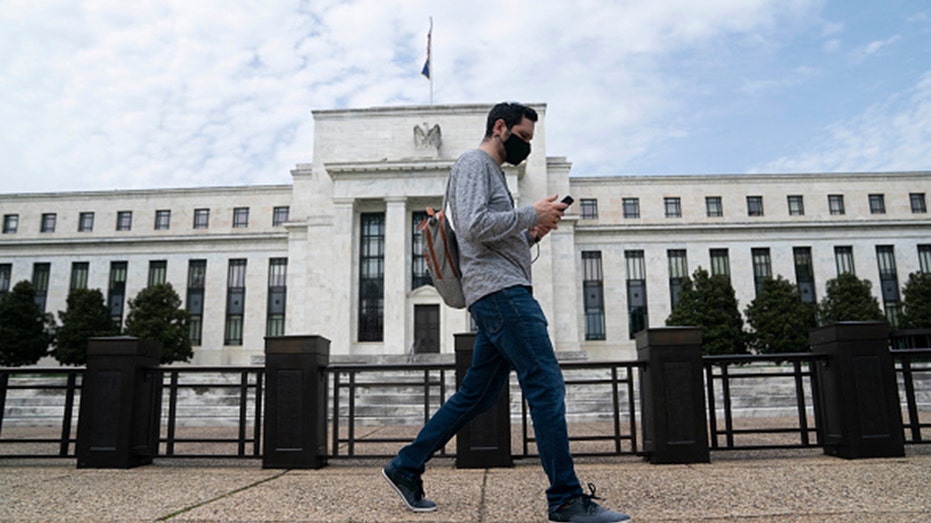Red-hot inflation report amps up pressure on Federal Reserve to act
Economists expect the Fed to raise rates by 50 basis points to quell inflation
The bond market says to pay attention as the Fed is going to get aggressive: Jim Bianco
FOX Business correspondent Jeff Flock and Bianco Research president Jim Bianco provide insight on food shortages and inflation on 'Making Money.'
Inflation rose in March at the fastest pace in 1981, ratcheting up pressure on the Federal Reserve to move even more aggressively to tame soaring consumer prices.
The Labor Department said Tuesday that the consumer price index – which measures a bevy of goods including gasoline, health care, groceries and rents — rose 8.5% in March from a year ago, the fastest pace since December 1981, when inflation hit 8.9%. Prices jumped 1.2% in the one-month period from February, the largest month-to-month jump since 2005.
FED RAISES INTEREST RATES FOR FIRST TIME IN 3 YEARS, PROJECTS 6 MORE HIKES AS INFLATION SURGES
So-called core prices, which exclude more volatile measurements of food and energy, climbed 6.5% in March from the previous year — up from the 6.4% increase recorded in February. It was the steepest 12-month increase since August 1982.
The latest inflation reading, which is the last before Fed officials meet on May 3-4, marks the 10th consecutive month the gauge has been above 5%. The Fed strives to keep inflation around 2%.

Federal Reserve Board Chair Jerome Powell testifies before Senate Banking, Housing, and Urban Affairs hearing to examine the Semiannual Monetary Policy Report to Congress, Thursday, July 15, 2021, on Capitol Hill in Washington. (AP Photo/Jose Luis Magana / AP Newsroom)
The data will most certainly have major implication for the Fed, which has already taken a more hawkish approach to fight inflation in recent months: Policymakers raised rates by a quarter-point in March and have since signaled support for a faster, half-point increase at their May meeting.
"[This report] provides additional support for the Fed to raise interest rates by half a percentage point at that meeting and at the June meeting, too," said Bill Adams, chief economist for Comerica Bank. "The Fed is concerned that this latest surge in gas prices will reinforce a more inflationary mindset in the United States and make inflation persist at a higher level, even after gas prices come down."
Adams also predicted that central bankers will begin to unwind the Fed's massive $9 trillion balance sheet beginning in May. Policymakers have proposed shrinking the balance sheet at a maximum monthly pace of $60 billion in Treasurys and $35 billion in mortgage-backed securities, according to minutes from the Fed's March meeting.
By comparison, the Fed trimmed its balance sheet at a rate of $50 billion a month from 2017 to 2019.

A man wearing a mask walks past the U.S. Federal Reserve building in Washington D.C., the United States, on April 29, 2020. (Xinhua/Liu Jie via Getty Images / Getty Images)
"The March surge in inflation underscores the urgency at the Fed to push its policy rate higher," said Joe Brusuelas, RSM chief economist. Like Adams, Brusuelas expects central bankers will lift rates by 50 basis points in both May and June, setting the federal funds target range somewhere between 1.25% and 1.5% by mid-year.
Traders are now pricing in more than a 85% chance of a hefty half-point rate jump when policymakers meet next month, instead of a more modest quarter-point increase, according to the CME's FedWatch tool.
It would mark the first time since 2000 that the U.S. central bank raised the federal funds rate by 50 basis points.
The biggest question now is whether central bank officials can successfully tame inflation and stabilize prices without triggering an economic recession. Raising the federal funds rate tends to create higher rates on consumers and business loans, which slows the economy by forcing them to cut back on spending.
Chairman Jerome Powell has pushed back against concerns that further tightening by the central bank will trigger a recession and has maintained optimism that the Fed can strike a delicate balance between taming inflation without crushing the economy.
GET FOX BUSINESS ON THE GO BY CLICKING HERE
"The probability of a recession in the next year is not particularly elevated," Powell told reporters during the Fed's March meeting, citing the strong labor market, solid payroll growth and strong business and household balance sheets. "All signs are that this is a strong economy and one that will be able to flourish in the face of less accommodative monetary policy."





















